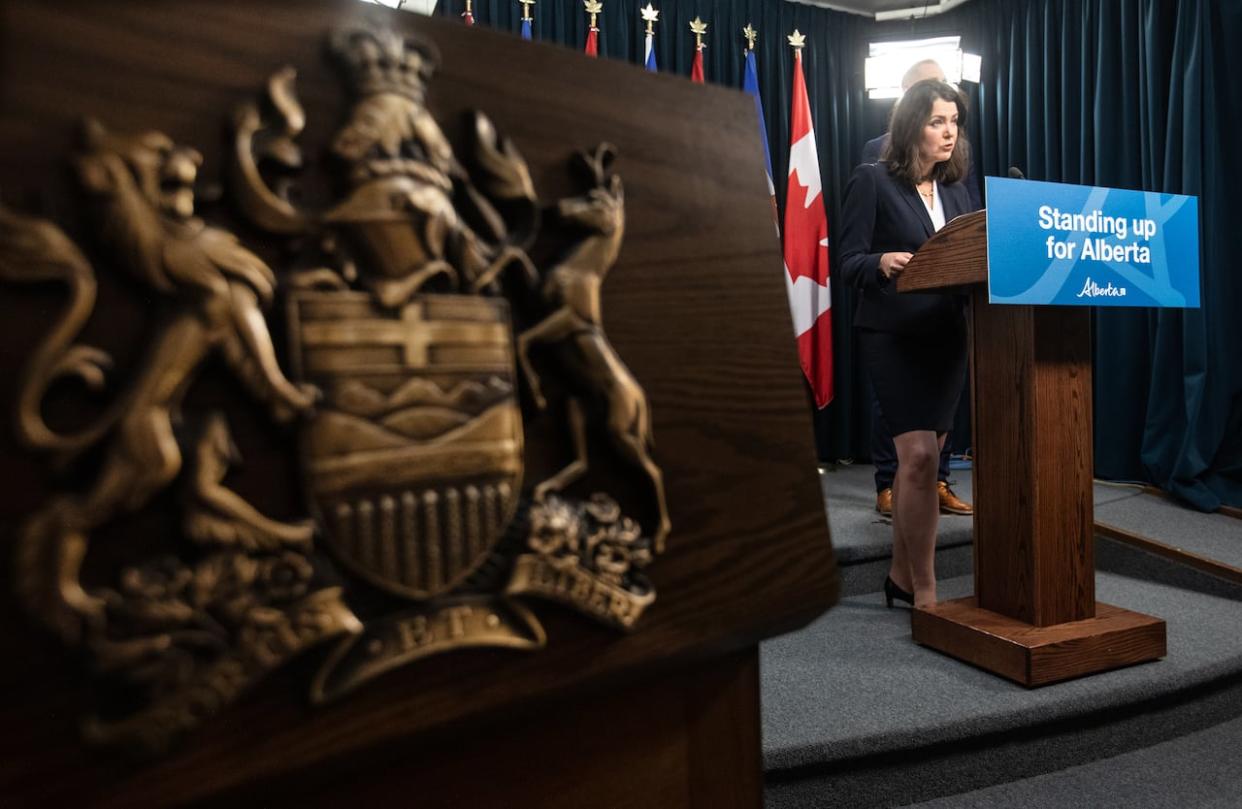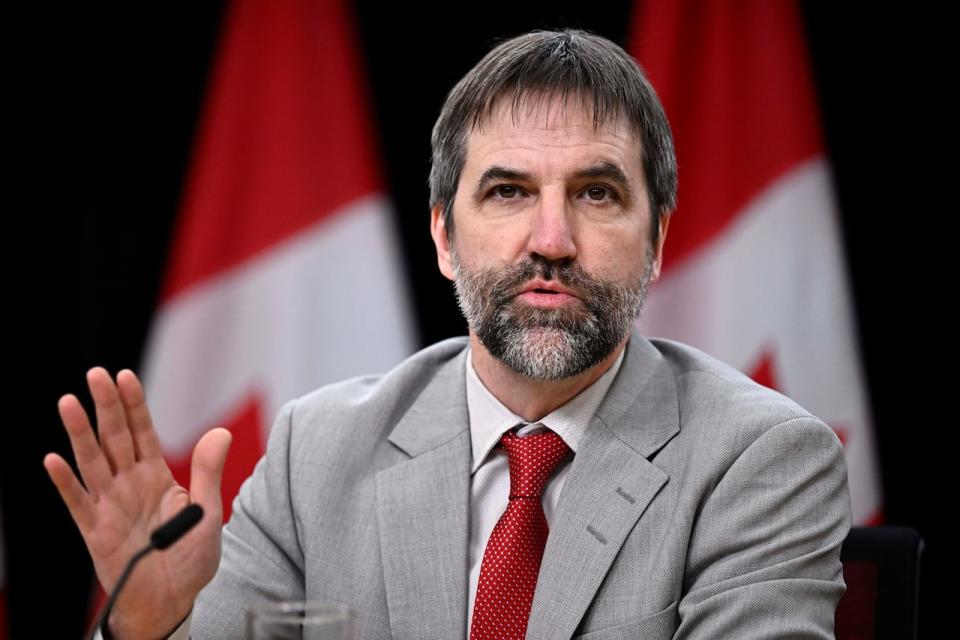What to know about the electricity regulations Alberta is threatening to defy

On Monday, Alberta tabled a bill that would invoke its Sovereignty Act for the first time, in response to the federal government's proposed regulations to reduce emissions from electricity generation to net-zero.
Shortly after, Premier Danielle Smith appeared on CBC's Power & Politics to discuss the move.
Host David Cochrane asked why her government was invoking the Sovereignty Act now while an Alberta-Ottawa working group was in the process of collaborating on the proposed Clean Electricity Regulations (CER), which are still in draft form.
"We had to draw a pretty firm line here," Smith replied. "We just know that 2035 target is not achievable."
Immediately following her interview, Environment and Climate Change Minister Jonathan Wilkinson spoke with Cochrane. Wilkinson called Alberta's move unfortunate, and said it represented a "victory of partisan politics over good public policy."
If you haven't been following this debate closely, it can be difficult to suss out exactly what everyone is talking about here. Perhaps you've only vaguely heard of "net-zero" and "2035" but are fuzzy on the details. Or maybe you've just seen the Alberta government's advertisements about freezing in the dark.
Though the issue may have been framed by politicians as involving a rigid 2035 net-zero deadline, when no more natural-gas-fired electricity generation will be allowed, the reality is more nuanced. The draft regulations have all sorts of exceptions that allow for significant amounts of emissions from electricity generation to continue well into the 2040s — and even some in 2050 and beyond.
So what's actually going on here?
Net-zero by 2035 (but not really)
Back in August, the federal government released the draft version of the CER, a set of rules for transitioning Canada's electricity grid to net-zero starting in 2035. The United States, among other G7 countries, have similar goals.
The regulations are necessary, in the view of the federal government, not just to meet Canada's climate commitments but also to compete economically in a low-carbon future.
The regulations as proposed would see facilities that produce electricity being subject to a performance standard — with some exceptions.
By 2035, many facilities that generate electricity from natural gas (or other carbon-emitting fuel sources) would have to find ways to reduce emissions, whether that's carbon capture and storage or some other method.

Both provincial and federal politicians, including Minister of Environment and Climate Change Steven Guilbeault, have referenced 2035 as a sort of deadline when it comes to achieving a net-zero electricity grid. (Justin Tang/The Canadian Press)
Alberta has said it supports the implementation of a carbon-neutral power grid, but only by 2050. The province says it does not have enough non-emitting base load electricity sources such as hydro and nuclear available, and doesn't have enough time to build them by 2035.
The 2035 date has been held up by both provincial and federal politicians as a sort of deadline for all this.
"The Clean Electricity Regulations are an important part of the Government of Canada's actions to achieve a net-zero electricity grid by 2035," Environment Minister Steven Guilbeault says in a video posted on the official federal website for the regulations.
But, when you delve into the details of the CER, the 2035 date is, in fact, just a starting point for a longer process.
With the exceptions already carved into the draft regulations, some carbon-emitting facilities could continue running until 2045 — just five years before Alberta's goal of a net-zero economy by 2050.
Exceptions and future expectations
Under the draft regulations, there is a 20-year grace period for recently built facilities and any new facilities built by the end of 2024.
That means a plant built in 2015 or before would be subject to the full performance standard in 2035. But one built in 2024 could operate until 2044 unconstrained.
Contrary to some of the political rhetoric, there is no "all-out switch in 2035," said Jason Dion, senior research director with the Canadian Climate Institute.
"Some of the summaries of these policies, some of the knee-jerk reactions to it, assume it's a matter of flipping a switch in 2035 — and no more gas generation allowed," he said, noting that's not actually the case.
There are other flexibilities in the draft rules, too. They include:
An exemption for "peaker" power plants to run up to 450 hours per year to support peak power needs in hours when renewables and other sources aren't available.
An exemption for units with a capacity of less than 25 megawatts.
Exemptions for small and remote communities that "lack affordable options to use non-emitting electricity generation."
An exemption for "emergency circumstances."
There are also additional details in the regulations dealing with cogeneration, the simultaneous production of heat and electricity at industrial facilities — largely oilsands operations — that sees excess electricity sold to the grid.
Performance standards would also be applied to these facilities — a contentious part of the draft regulations, given concerns that these facilities might opt to eliminate their contributions to the grid.
As it stands, the majority of cogeneration capacity in Alberta would be subject to the regulations in 2035, according to an analysis from the Pembina Institute, a clean-energy think tank.
Excluding cogeneration, however, the regulations offer a lot more flexibility.
The various exemptions mean that a majority of the gas-fired generation capacity in Alberta would not actually be subject to the regulations as of 2035, according to the same analysis from the Pembina Institute.
By 2040, the institute projects that roughly half of the natural gas generation would be subject to the rules.
"The draft regulations as proposed provide a strong signal to [generators] that they need to be reducing, and then give them that headspace to ramp down their emissions during that period of time, well into the 2040s," said Jason Wang, as senior electricity analyst with the institute.
And that's with the draft regulations in their current form. There could be changes.
This week, Wilkinson was quoted by The Canadian Press as saying he could consider making the 20-year grace period even longer in order to address Alberta's concerns around reliability and affordability.
In response to a request for comment from CBC News, a spokesperson in his office said Ottawa was eager to continue consulting on all provisions in the draft regulations, but no decision had yet been made on a path forward.
"We will also note that while some stakeholders have asked that this provision be relaxed, others have asked to make it more stringent," Oliver Anderson wrote.
Andrew Leach, an energy and environmental economist with the University of Alberta, has issues with the draft as presented.
In addition to raising concerns around cogeneration, he's argued the limit for peaker power plants should be expanded, potentially considering an averaging over multiple years (instead of an annual limit), as requirements can vary from year to year.
So why is Alberta so unhappy?
To understand that question, let's zoom out for a moment to discuss how the CER approaches transitioning Canada's electricity grid to net-zero by 2050.
It suggests doing so largely through electrifying parts of the economy that currently rely on fossil fuels, such as vehicles and heating.
That's important to overall decarbonization plans for the province and country, according to Sara Hastings-Simon, a professor of earth, energy and environment at the University of Calgary's School of Public Policy.
"One big chunk of that, one big lever that we have to pull, is to so-called 'electrify' our uses of energy," she said.
Switching from fossil fuels to electricity won't have much effect on emissions, however, if that electricity is generated by burning fossil fuels. That's why the federal regulations are aimed at decarbonizing the electrical grid itself — by moving away from natural gas generation, in particular.
The issue for Alberta is that, unlike most of the rest of the country, it gets the majority of its electricity from natural gas.
Alberta has argued that current technology will not allow for the province to hit the targets Ottawa has suggested, and attempting to do so would lead to affordability and reliability issues.

Andrew Leach, the energy and environmental economist with the University of Alberta, says the draft Clean Electricity Regulations (CER) can be improved in various ways given Alberta's unique energy landscape. (Submitted by Andrew Leach)
Leach says the uncertainty involved in all of this, paired with Alberta's competitive electricity market, poses some unique challenges.
With dozens of independent generators selling electricity to the grid in an open market, Alberta faces a more complicated road ahead than a province like Saskatchewan does with SaskPower — that is, one provider making decisions on the investments it will undertake.
"What is Alberta going to have to do to meet these regulations? The easy answer is, it depends a lot on what decisions Capital Power, Enmax, TransAlta and other generators make about what to build," Leach said.
"If they all say, 'we're not going to build anything,' then that makes it a harder problem for the government to solve."
When it comes to the apparent chasm between Alberta and Ottawa, Leach said Alberta will need to develop a "credible set of policies" that will get its economy to net-zero by 2050, or at least "reasonably close."
"Then, they're having a very different conversation with the federal government," Leach said.
With a proposed coming-into-force date of Jan. 1, 2025, experts like Leach feel as though there's plenty of time for revisions to be added to the draft document to address the unique challenges faced by the province.


